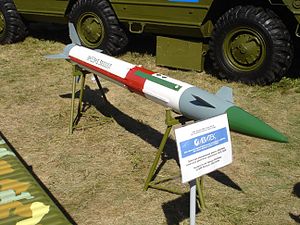9K33 Osa
| 9K33 Osa (NATO reporting name: SA-8 Gecko) |
|
|---|---|

9A33BM transporter erector launcher and radar (TELAR)
|
|
| Type | 6x6 amphibious SAM system |
| Place of origin | Soviet Union |
| Service history | |
| In service | 1971-present |
| Used by | See list of present and former operator |
| Wars | 1982 Lebanon War, Angolan Civil War, Persian Gulf War, 2008 Russo-Georgian war, 2011 Libyan civil war |
| Production history | |
| Designer | NII-20 Research Institute |
| Designed | 1960-1972 |
| Manufacturer | Znamya Truda Plant |
| Produced | 1970-1988 |
| Number built | 1200 |
| Variants | OSA-A, OSA-AK, OSA-AKM, OSA-M |
| Specifications (OSA-AKM) | |
| Weight | 17.5 tonnes |
| Length | 9.14 m |
| Width | 2.75 m |
| Height | 4.20 m (radar mast stowed) |
| Crew | 5 soldiers |
|
|
|
|
Main
armament |
6 9M33, 9M33M1, 9M33M2 or 9M33M3 missiles |
| Engine | D20K300 diesel |
| Ground clearance | 400 mm |
|
Operational
range |
500 km |
| Speed | 80 km/h 8 km/h (swimming) |
| 9M33 | |
|---|---|

The 9M33M3 missile
|
|
| Type | Surface-to-air missile |
| Place of origin | Soviet Union |
| Service history | |
| In service | 1971-present |
| Used by | See list of present and former operator |
| Production history | |
| Designer | MKB "Fakel" |
| Designed | 1960-1972 |
| Manufacturer | Znamya Truda Plant |
| Produced | 1970-1988 |
| Variants | 9M33, 9M33M1, 9M33M2, 9M33M3, 9A33BM3 |
| Specifications (9K33M3) | |
| Weight | 170 kg |
| Length | 3158 mm |
| Diameter | 209.6 mm |
| Warhead | Frag-HE |
|
Detonation
mechanism |
Contact and proximity |
|
|
|
| Propellant | Solid propellant rocket motor |
|
Operational
range |
15 kilometres (9.3 mi) |
| Flight altitude | 12,000 metres (39,000 ft) |
| Boost time | 2 s boost, then 15 s sustain |
| Speed | 1020 m/s |
|
Guidance
system |
RF CLOS |
|
Steering
system |
dual-thrust rocket motor. |
| Accuracy | 5 m |
|
Launch
platform |
9P35M2 |
The 9K33 Osa (English: wasp) is a highly mobile, low-altitude, short-range tactical surface-to-air missile system. "9K33" is its GRAU designation. Its NATO reporting name is SA-8 Gecko. Its export version name is Romb.
The SA-8 was the first mobile air defense missile system incorporating its own engagement radars on a single vehicle.
All versions of the 9K33 feature all-in-one 9A33 transporter erector launcher and radar (TELAR) vehicles which can detect, track and engage aircraft independently or with the aid of regimental surveillance radars. The six-wheeled transport vehicles BAZ-5937 are fully amphibious and air transportable. The road range is about 500 km.
The 1S51M3-2 radar system on the SA-8 TELAR received the NATO codename Land Roll. It was derived from the naval `Pop Group' radar system but is smaller since it does not require the elaborate stabilisation system. An improved system designated the SA-8B `Gecko' Mod 1, was first seen in Germany in 1980. It had improvements added to the launcher configuration, carrying six missiles in ribbed containers. The system is reported to be of the frequency-agile monopulse type. It consists of an elliptical rotating surveillance antenna mounted on top of the array, operates in H band (6 to 8 GHz) and has a 30 km acquisition range against most targets. The large pulsed J band (14.5 GHz) engagement antenna is mounted below it in the centre of the array and has a maximum tracking range of about 20 km.
Mounted on either side of the tracking radar antenna is a small J band parabolic dish antenna to track the missile. Below that is a small circular antenna which emits an I band uplink capture beam to gather the missile shortly after launch. The final antennas in the array are two small white rectangular ones, one on either side of the array mounted alongside the I band. These are used for command uplink to the missile. This twin antenna system permits the 'Land Roll' radar to control up to two missiles simultaneously against a single target. Furthermore, the two missiles can be guided on different frequencies to further complicate ECM. There is also a tubular device fitted to and above the tracking radar; this is a 9Sh33 electro-optical tracker. It can be used to track the target when the main tracking radar is jammed by ECM.
A 9K33 battery comprises four 9A33B TELAR vehicles and two 9T217 transloader vehicles on BAZ-5939 chassis with reload missiles and a crane. A reload time of five minutes has been reported per TELAR.
...
Wikipedia
